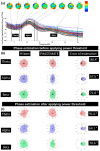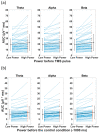Pre-Stimulus Power but Not Phase Predicts Prefrontal Cortical Excitability in TMS-EEG
- PMID: 36831986
- PMCID: PMC9953459
- DOI: 10.3390/bios13020220
Pre-Stimulus Power but Not Phase Predicts Prefrontal Cortical Excitability in TMS-EEG
Abstract
The cortical response to transcranial magnetic stimulation (TMS) has notable inter-trial variability. One source of this variability can be the influence of the phase and power of pre-stimulus neuronal oscillations on single-trial TMS responses. Here, we investigate the effect of brain oscillatory activity on TMS response in 49 distinct healthy participants (64 datasets) who had received single-pulse TMS over the left dorsolateral prefrontal cortex. Across all frequency bands of theta (4-7 Hz), alpha (8-13 Hz), and beta (14-30 Hz), there was no significant effect of pre-TMS phase on single-trial cortical evoked activity. After high-powered oscillations, whether followed by a TMS pulse or not, the subsequent activity was larger than after low-powered oscillations. We further defined a measure, corrected_effect, to enable us to investigate brain responses to the TMS pulse disentangled from the power of ongoing (spontaneous) oscillations. The corrected_effect was significantly different from zero (meaningful added effect of TMS) only in theta and beta bands. Our results suggest that brain state prior to stimulation might play some role in shaping the subsequent TMS-EEG response. Specifically, our findings indicate that the power of ongoing oscillatory activity, but not phase, can influence brain responses to TMS. Aligning the TMS pulse with specific power thresholds of an EEG signal might therefore reduce variability in neurophysiological measurements and also has the potential to facilitate more robust therapeutic effects of stimulation.
Keywords: EEG power before TMS; TMS-EEG; brain state; cortical oscillations; phase before TMS.
Conflict of interest statement
Z.J.D. has received research and equipment in-kind support for an investigator-initiated study through Brainsway Inc. and Magventure Inc. He is also on the scientific advisory board for Brainsway Inc. His work has been supported by the National Institutes of Mental Health (NIMH), the Canadian Institutes of Health Research (CIHR), Brain Canada and the Temerty Family, Grant and Kreutzcamp Family Foundations. D.M.B. receives research support from CIHR, NIH, Brain Canada, and the Temerty Family through the CAMH Foundation and the Campbell Research Institute. He received research support and in-kind equipment support for an investigator-initiated study from Brainsway Ltd. and he is the site principal investigator for one sponsor-initiated study for Brainsway Ltd. He also receives in-kind equipment support from Magventure for investigator-initiated studies. He received medication supplies for an investigator-initiated trial from Indivior. He participated in a Scientific Advisory Board for Janssen and Welcony Inc. C.Z. and B.Z. are shareholders of sync2brain GmbH (Tübingen, Germany), a start-up commercializing real-time EEG analysis technology. TKR has received research support from Brain Canada, Brain and Behavior Research Foundation, BrightFocus Foundation, Canada Foundation for Innovation, Canada Research Chair, Canadian Institutes of Health Research, Centre for Aging and Brain Health Innovation, National Institutes of Health, Ontario Ministry of Health and Long-Term Care, Ontario Ministry of Research and Innovation, and the Weston Brain Institute. T.K.R. also received for an investigator-initiated study in-kind equipment support from Newronika, and in-kind research online accounts from Scientific Brain Training Pro, and participated in 2021 in an advisory board for Biogen Canada Inc. DV. holds the Labatt Family Professorship in Depression Biology, a University Named Professorship at the University of Toronto. She receives research support from CIHR, the Centre for Addiction and Mental Health (CAMH) and the Department of Psychiatry at the University of Toronto. D.V. declares no biomedical interests or conflicts. M.P., R.Z., C.H., A.T.H., I.H. and R.C. have nothing to disclose.
Figures






References
-
- Rossini P.M., Burke D., Chen R., Cohen L.G., Daskalakis Z., Di Iorio R., Di Lazzaro V., Ferreri F., Fitzgerald P.B., George M.S., et al. Non-Invasive Electrical and Magnetic Stimulation of the Brain, Spinal Cord, Roots and Peripheral Nerves: Basic Principles and Procedures for Routine Clinical and Research Application. An Updated Report from an I.F.C.N. Committee. Clin. Neurophysiol. 2015;126:1071–1107. doi: 10.1016/j.clinph.2015.02.001. - DOI - PMC - PubMed

